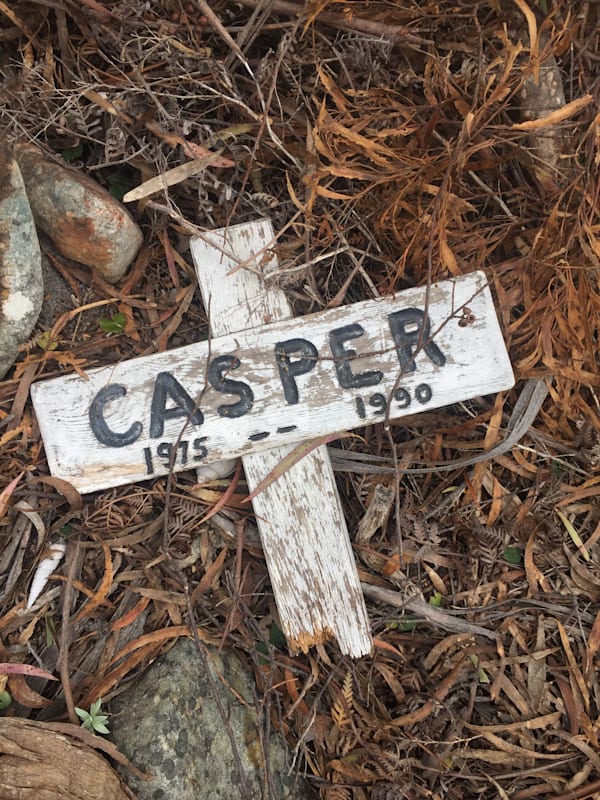photographer Lian Tanner
I must have walked past it a dozen times without realising it was there. But one day last winter, something caught my eye. A wooden cross. A scattering of bricks.
As cars rumbled along South Arm Rd at the bottom of the hill, I left the gravel road and pushed through the bracken and the clumps of tea tree to investigate.
At first I thought it was a rubbish dump. Then I saw the remains of a small, white picket fence set in a rectangle, and headstones poking out of the ground, with the occasional aluminium plaque. Some had old vases tucked down the side, or plastic flowers. A few of the crosses were intact; most were broken and rotting among the branches.
It could have been an abandoned human cemetery – all the markers, all the care and love gone into those small monuments. But the names and inscriptions told a different story.
“TIGER, A TRUE PAL.”
“HYPO, A LITTLE FELLA THAT WE ALL MISS.”
“RAGS, OUR OLD ENGLISH SHEEPDOG. YOU TAUGHT US ALL THE MEANING OF LOVE.”
The Sandville pet cemetery was established in the mid-1970s by Nannette and Erick Werner, who owned 145 hectares and a riding school south of Sandford.
“It was mum's idea,” says Nannette's son, Rick Cuthbertson. “Us boys were upset because the local vet used to take dead dogs to the tip. There was nowhere else. And mum thought, well that's not good enough.”
The cemetery took a while to get started, mostly because of council regulations, which included the stipulation that they weren't allowed to bury anything bigger than a goat.
But once they had approval, they cleared a plot of land below the house and put a couple of advertisements in the paper.
“When the ads went in, we got a lot of abusive phone calls. People thought we were making money out of someone's grief,” says Rick. “But it was never about money. It was just so they had somewhere to bury their animals.”
It was the first pet cemetery in Tasmania, and Erick used an old Ford ambulance for pickups.

“Then they'd turn up with a shi-tzu. Or a St Bernard. So we'd have to re-dig the hole. We had three St Bernards over the years. They were bigger than a goat, I reckon.”
Most people brought their pet wrapped in a blanket, though Rick's younger brother Guy had a dog turn up in a little handmade coffin.
“We had to see what we were burying,” says Rick, “otherwise you could end up in all sorts of strife. That was Erick's rule. He was a cautious sort of person.”
A few people just paid and left; they were the ones who never came back.
“But some were beside themselves, they could hardly walk. We tried to be as gentle as we could. Talked to them, tried to make it easier for them.”
By 1992 there were more than a thousand pets buried on that bush block. It was mainly dogs and cats, but there were rabbits, too, and a couple of goats, and a bird.
A newspaper photo from the time shows Erick kneeling by a row of small, carefully tended graves, with white picket fences around each one, and wooden crosses.
“You'd come home and there'd be two or three cars there,” says Rick. “People just walking around. Some of them came quite often. They really appreciated being able to visit their pets whenever they wanted.”
Erick, Rick and his brothers kept the grounds in order, pulling the bracken out and making paths. But it was up to the pet owners to maintain the graves. They left leashes and collars, and nametags hanging on the little crosses. There were photos, food bowls and favourite toys.
And then there were the headstones. Sandstone. Granite. Marble. “Some people spent heaps. Like, thousands of dollars. They'd handpick where they wanted to bury their animals, or they'd pre-book a spot because they wanted to keep all their pets in the same area.”
Rick's older brother Mark buried two dogs in the cemetery, Brutus and Mr G. Erick carved a Huon pine headstone in the shape of an open book for Mr G, with an engraved poem that Mark wrote.
Rick's got dogs there, too: Dusty, a boxer, and little Grover. “He was a menace, Grover. He killed chooks, killed anything he could get hold of. But I loved him.”
The cemetery closed in the mid-1990s when the original 145 hectares was cut up into big blocks and sold off, and the new owners weren't interested in maintaining it. “There was a bit of a protest,” says Rick, “people wanting to get in to visit their pets. But it was fenced off, with keep out signs.”
The signs are long gone now, and so is the fence. Erick is 84 and living in the Daintree; Nannette died back in 2008.
The old cemetery slumbers in the winter sunlight.
“It was sad, but in other ways it was a happy place,” says Rick. “Peaceful. A bush setting with all these inviting little tracks.”
He shakes his head, remembering. “Probably where I'd want to end up.”
Lian Tanner has been dynamited while scuba diving and arrested while busking. She once spent a week in the jungles of Papua New Guinea, hunting for a Japanese soldier left over from WWII. Her best-selling Keepers Trilogy has been translated into 11 languages, and won two consecutive Aurealis Awards for Best Australian Children’s Fantasy. Her first picture book "Ella and the Ocean", illustrated by Jonathan Bentley, won the NSW Premier’s Award for Children’s Literature. Her latest children’s novel is "A Clue for Clara", a puzzling and hilarious mystery about a small chook and a big crime. More about Lian and her writing can be found at liantanner.com.au.










